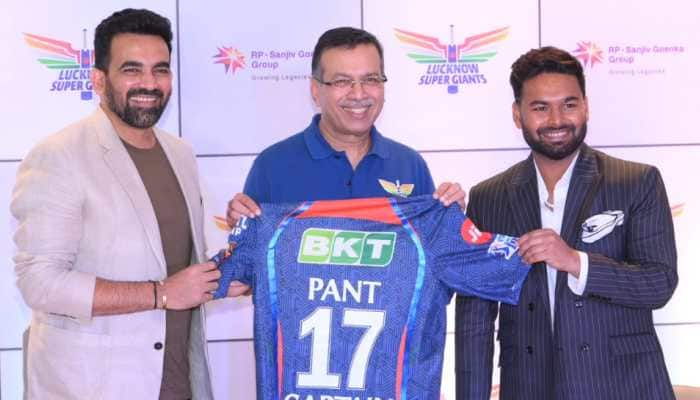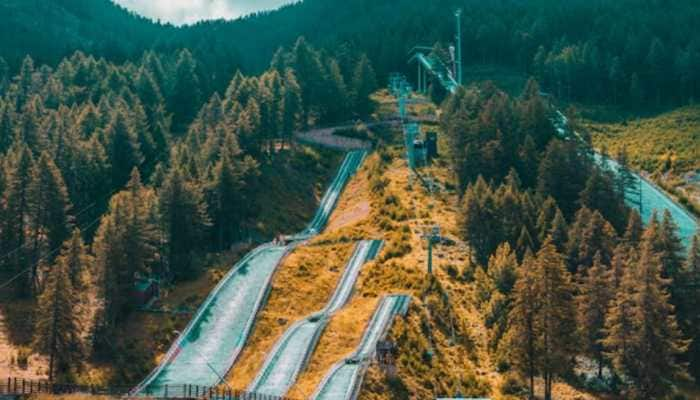Train tragedies: Mamata on the backfoot
Frequent train disasters have badly tarnished Mamata’s image as a leader of masses.
Trending Photos
)
 Ritesh K Srivastava
TMC chief Mamata Banerjee’s stint as Union Railway Minister in the past one year has been extremely disappointing. Frequent train disasters have badly tarnished Mamata’s pro-people’s image since Railways are the lifeline of India and the common man’s means of transportation.
After General Elections, Mamata’s induction in the UPA-II as Railways Minister was welcomed amid hopes that the firebrand politician will revive the fortunes of Indian Railways and rescue it from the gimmickry of her predecessor Lalu Yadav.
Blot on pro-people image
Known for her clean image in politics, Didi has clearly failed to restore people’s waning faith in railways as the safest mode of transport in India.
Misleading statements made by Mamata Banerjee, her pointless attack on Left and her ‘conspiracy theories’ after every train mishap has only spoiled her reputation as a leader of the masses.
She might have introduced new trains, launched various innovative services, reduced cost of running trains and kept the rail fares untouched, but she has undoubtedly failed to prevent the loss of precious human lives in train accidents.
In the wake of train tragedies one after another, the crusader from West Bengal is finding it hard to justify her continuance in the central cabinet as Union Minister of Railways.
Mamata’s only agenda seems to be prising West Bengal from the clutches of the Left and strengthening her party’s support base in her home state. Buoyed by TMC’s recent victory over the Left Front in the West Bengal municipal polls, Didi seems to be focussing more on the Left’s misrule than improving the state of Indian Railways.
Probably this has given credence to the Opposition’s hue and cry over her constant ignorance of her Ministry as one of the factors responsible for the poor state of Railways.
Autocratic mannerism
It seems that Left’s divorce from the Congress-led UPA alliance has given Mamata a free hand to run the Indian Railways in a ham-fisted manner. In the past one year, she has transferred over a dozen Railway Board Chairman without assigning any reason. She has been facing flak for transferring top railways official before the completion of their mandatory three-year term, again for no apparent reasons. It is sad to see how top railway officials are blaming in one voice the Uttar Banga Express driver Madhab Chandra Dey- a recipient of the Driver of the Year Award from the railways- for the Sainthia tragedy.
The family of Dey, who died on the spot in the Sainthia train tragedy, is deeply hurt by accusations of ‘erratic behaviour’ levelled on him.
Vital statistics
If we go by statistics, then the latest train accident at Sainthia in West Bengal`s Birbhum district, which claimed the lives of at least 66 people and injured over 150 passengers, is the sixth major tragedy in the past one year and the second in less than two months in the state.
An analysis of data on train accidents over the past 20 years shows that Mamata Banerjee as a Rail Minister is no better than her predecessors. A look at the number of causalities in train accidents since financial year 1990-91 makes Mamata the fifth worst performer in the dubious list of worst rail ministers.
The year 1995-96, when CK Jaffer Sharief was the Railway Minister, a total of 427 deaths took place making him the worst minister in recent times. With 374 fatalities in 1999-2000, Nitish Kumar comes second in this list. He is followed by Lalu Yadav as there were 302 deaths in 2006-07 when he was the minister.
Looking at Mamata’s performance from November 10, 2009 to July 19, 2010, more than 233 deaths have occurred so far. The figure is unacceptably high.
If we look at the total number of casualties taking place during the entire tenure of a minister, then the terms of CK Jaffer Sharief and Lalu Prasad Yadav saw over 900 deaths each. Nitish Kumar served two terms of two years each, during which 900 fatalities occurred However, if compared with them, Mamata`s past term (of about two years) along with her current tenure has so far witnessed 518 fatalities.
Rail accidents claim one person every second day considering the average fatalities for the past 20 years which is 186 per year. However, the sad part of Indian Railways’ success story has been that there are still so many deaths despite technological advancements. Rampant corruption
Rampant corruption in Indian Railways, the formidable nexus of rail agents and travel agencies, flawed ticket booking rules, improper administration resulting in chaos at major railway stations and lack of proper security has only annoyed the common man.
Of late, the Railways has come under scanner for not working in coordination with security agencies, violating its safety policies, and not fulfilling its responsibility by stepping up precautionary measures to protect passengers and railway property in danger zones.
It is very unpleasant that every time a tragedy occurs, Centre and state governments as well as Railways merely announce obligatory compensations for victims and get on with relief and rescue operations.
What is further disappointing is to know that the money meant for upgrading safety of trains and passengers is often diverted to the expansion of rail networks.
Each time a new minister takes charge of the Railways, providing better train connectivity to his native state or his constituency becomes his foremost policy.Measures required
It is also true that accidents are unpredictable, but the scale of human suffering, loss of lives, and destruction of properties worth billions of rupees can surely be minimised to a great extent.
And for this, the concerned authorities need to take extra measures that include training and imparting new skills, providing better equipment for surveillance and monitoring, better co-ordination among Centre and state agencies, well-equipped armed forces for security and an efficient disaster response mechanism.
The Anti-Collision Devices meant for averting major accidents must be installed in a speedy manner across all zones of Indian Railways.
The Indian Railways boast of being the third largest rail network after Russia and China and being the largest employer among railway networks of the world, but the frequent train tragedies mars its success story.
Slow modernisation, lack of technical know-how, human error and the armed conflict by the home-grown Naxals have all made Indian Railways vulnerable to such an extent that passengers are now scared of travelling by trains.
This also raises doubts over our ability and preparedness to start high-velocity bullet trains in India.
It is high time that Mamata Didi wakes up from deep slumber and takes steps required to rescue Railways from all that ails it.
Ritesh K Srivastava
TMC chief Mamata Banerjee’s stint as Union Railway Minister in the past one year has been extremely disappointing. Frequent train disasters have badly tarnished Mamata’s pro-people’s image since Railways are the lifeline of India and the common man’s means of transportation.
After General Elections, Mamata’s induction in the UPA-II as Railways Minister was welcomed amid hopes that the firebrand politician will revive the fortunes of Indian Railways and rescue it from the gimmickry of her predecessor Lalu Yadav.
Blot on pro-people image
Known for her clean image in politics, Didi has clearly failed to restore people’s waning faith in railways as the safest mode of transport in India.
Misleading statements made by Mamata Banerjee, her pointless attack on Left and her ‘conspiracy theories’ after every train mishap has only spoiled her reputation as a leader of the masses.
She might have introduced new trains, launched various innovative services, reduced cost of running trains and kept the rail fares untouched, but she has undoubtedly failed to prevent the loss of precious human lives in train accidents.
In the wake of train tragedies one after another, the crusader from West Bengal is finding it hard to justify her continuance in the central cabinet as Union Minister of Railways.
Mamata’s only agenda seems to be prising West Bengal from the clutches of the Left and strengthening her party’s support base in her home state. Buoyed by TMC’s recent victory over the Left Front in the West Bengal municipal polls, Didi seems to be focussing more on the Left’s misrule than improving the state of Indian Railways.
Probably this has given credence to the Opposition’s hue and cry over her constant ignorance of her Ministry as one of the factors responsible for the poor state of Railways.
Autocratic mannerism
It seems that Left’s divorce from the Congress-led UPA alliance has given Mamata a free hand to run the Indian Railways in a ham-fisted manner. In the past one year, she has transferred over a dozen Railway Board Chairman without assigning any reason. She has been facing flak for transferring top railways official before the completion of their mandatory three-year term, again for no apparent reasons. It is sad to see how top railway officials are blaming in one voice the Uttar Banga Express driver Madhab Chandra Dey- a recipient of the Driver of the Year Award from the railways- for the Sainthia tragedy.
The family of Dey, who died on the spot in the Sainthia train tragedy, is deeply hurt by accusations of ‘erratic behaviour’ levelled on him.
Vital statistics
If we go by statistics, then the latest train accident at Sainthia in West Bengal`s Birbhum district, which claimed the lives of at least 66 people and injured over 150 passengers, is the sixth major tragedy in the past one year and the second in less than two months in the state.
An analysis of data on train accidents over the past 20 years shows that Mamata Banerjee as a Rail Minister is no better than her predecessors. A look at the number of causalities in train accidents since financial year 1990-91 makes Mamata the fifth worst performer in the dubious list of worst rail ministers.
The year 1995-96, when CK Jaffer Sharief was the Railway Minister, a total of 427 deaths took place making him the worst minister in recent times. With 374 fatalities in 1999-2000, Nitish Kumar comes second in this list. He is followed by Lalu Yadav as there were 302 deaths in 2006-07 when he was the minister.
Looking at Mamata’s performance from November 10, 2009 to July 19, 2010, more than 233 deaths have occurred so far. The figure is unacceptably high.
If we look at the total number of casualties taking place during the entire tenure of a minister, then the terms of CK Jaffer Sharief and Lalu Prasad Yadav saw over 900 deaths each. Nitish Kumar served two terms of two years each, during which 900 fatalities occurred However, if compared with them, Mamata`s past term (of about two years) along with her current tenure has so far witnessed 518 fatalities.
Rail accidents claim one person every second day considering the average fatalities for the past 20 years which is 186 per year. However, the sad part of Indian Railways’ success story has been that there are still so many deaths despite technological advancements. Rampant corruption
Rampant corruption in Indian Railways, the formidable nexus of rail agents and travel agencies, flawed ticket booking rules, improper administration resulting in chaos at major railway stations and lack of proper security has only annoyed the common man.
Of late, the Railways has come under scanner for not working in coordination with security agencies, violating its safety policies, and not fulfilling its responsibility by stepping up precautionary measures to protect passengers and railway property in danger zones.
It is very unpleasant that every time a tragedy occurs, Centre and state governments as well as Railways merely announce obligatory compensations for victims and get on with relief and rescue operations.
What is further disappointing is to know that the money meant for upgrading safety of trains and passengers is often diverted to the expansion of rail networks.
Each time a new minister takes charge of the Railways, providing better train connectivity to his native state or his constituency becomes his foremost policy.Measures required
It is also true that accidents are unpredictable, but the scale of human suffering, loss of lives, and destruction of properties worth billions of rupees can surely be minimised to a great extent.
And for this, the concerned authorities need to take extra measures that include training and imparting new skills, providing better equipment for surveillance and monitoring, better co-ordination among Centre and state agencies, well-equipped armed forces for security and an efficient disaster response mechanism.
The Anti-Collision Devices meant for averting major accidents must be installed in a speedy manner across all zones of Indian Railways.
The Indian Railways boast of being the third largest rail network after Russia and China and being the largest employer among railway networks of the world, but the frequent train tragedies mars its success story.
Slow modernisation, lack of technical know-how, human error and the armed conflict by the home-grown Naxals have all made Indian Railways vulnerable to such an extent that passengers are now scared of travelling by trains.
This also raises doubts over our ability and preparedness to start high-velocity bullet trains in India.
It is high time that Mamata Didi wakes up from deep slumber and takes steps required to rescue Railways from all that ails it.Stay informed on all the latest news, real-time breaking news updates, and follow all the important headlines in india news and world News on Zee News.
Advertisement
Live Tv
Advertisement







)
)
)
)
)
)
)
)
)
)
